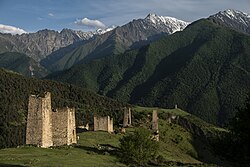Top Qs
Timeline
Chat
Perspective
Falkhan
Rural locality in Ingushetia From Wikipedia, the free encyclopedia
Remove ads
Falkhan (Russian: Фалхан, Ingush: Фалхан) is a rural locality (aul) in the Dzheyrakhsky District of Ingushetia, Russia. It is part of the Lyazhgi rural settlement.[5]
Founded around the 16–17th centuries, Falkhan was considered one of the historical cradles of Ingush people. The village once consisted of three Ingush battle towers, one semi-combat tower and twelve residential towers. The towers were five storeys high, with flat roofs and high parapets.
Remove ads
Name
The toponym is of ancient origin. It can be broken into three parts: Falkha-n-e, where "-n" and "-e/ye" are suffixes of the Ingush language.[6] The ethnonym Falkhankhoy (a teip) derives its name from Falkhan.[7] According to Akhmad Suleymanov, the name of the village is associated with the Ingush word fala (фала), meaning "free".[8]
Geography
Falkhan is located in the Kistin Gorge, on the slope of the spurs of Mount Myat-Loam (Table Mountain).[9] It lies south of the village of Metskhal and southwest of village of Khast-Mokie. Several pastures and meadows are located nearby, including Tielta, Velkh Tsona, Dal-Tsonashkie, Mekhanchie, and others. In addition, there are old places of worship such as Myat-Selash, Ashp-Koag, Gerg-Argie, and Motskharashkie.[10]
Remove ads
History
Summarize
Perspective
Background
Falkhan, along with the villages of Targim, Egikal, Khamkhi, Erzi, Metskhal, Goust, and Furtoug, is considered part of the historical cradle of the Ingush people.[11][12] According to ethnographer Bashir Dalgat, all of the villages and settlements (more than 20) of the Fyappin Society originate from Falkhan.[13] The village population was primarily composed of Dzarakhovs, as well as Adzhievs, Bersanovs, Umarovs, and Kotievs.[14]
According to legend, the village was founded by Ferkhast and his three sons who left the village of Tyarsh. The territory of the village originally belonged to the Ghamneaqan tribe (Ingush: ГIамнаькъан), which made it difficult for others to settle there.[15] According to the same legend, the Ghamneaqan were later killed by the inhabitants of Falkhan.[16][15]
The inhabitants engaged in the manufacture of items from horn, clay, bone, and wood, as well as archery weapons. Cloth production was developed, and there were deposits of sulphur and saltpetre, along with ores of copper, sulphur pyrites, brown iron ore, lead, zinc, and ochre.[17]
The complex has attracted significant scholarly interest and have been studied by prominent Russian and Soviet archaeologists. Thus, it has been studied by archeologists such as Leonid Semyonov, Ivan Shcheblykin, Evgeny Krupnov, Aleksey Robakidze, Vladimir Markovin, and Jabrail Chakhkiev.[18]
Russian rule
In 1811–1812, there were 30 households in Falkhan.[19][14] By the 1830s, the majority of Falkhan's inhabitants had migrated to the villages of Dzheyrakh-Yurt, Sholkhi, Ghalghai Yurt, and the Fortress of Vladikavkaz, located in the Ingush plain.[20] By the mid-19th century, the Dzarakhovs and Kotievs of Falkhan had also migrated to the village of Angusht. During this period, a mosque and a madrassa were built opposite the Solar Necropolis of Falkhan, with the help of the Andi theologian Murdal-Hajji. Dibr-Mulla served as the imam of the mosque at Murdal-Hajji’s request.[17] In 1886, there were 22 families living in Falkhan: ten Dzarakhov families, three Kotiev families, three Bersanov families, and two Adzhiev families.[14]
On 23 February 1944, the inhabitants of Falkhan were deported during the forced relocation of the Chechens and Ingush to the Kazakh SSR and Kirghiz SSR. Those who returned from exile in 1957 were denied the right to resettle in the village. The towers and crypts of Falkhan were repeatedly explored in the 1930s and 1970s, with the results published in various scientific works.[17]
Modern
Today, the village and its historical sites are included in the Dzheyrakh-Assa Museum-Reserve, established in 1988. The archaeological monuments of mountainous Ingushetia, including Falkhan, continue to attract significant scholarly attention.[17]
Remove ads
Demographics
Remove ads
References
Bibliography
Wikiwand - on
Seamless Wikipedia browsing. On steroids.
Remove ads




